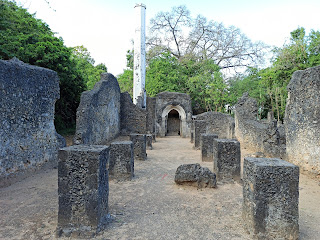Mnarani Ruins
| Mnarani Ruins | |
 |
|
| Image credit to Daniel Masake Kitui (Commons 4.0) | |
| Type: | Archeological site |
| Settlement: | 14th Century |
| Country: | |
The ruins were part of a Swahili city string on the African coast.[3] The mosque and tombs were built between 1475 and 1500.[4] According to the ruins' curator, William Tsaka, the original mosque was built around 1475, while the second one around 1500. In addition, hundreds of people went to the mosque to perform rituals, and they believed that the site was sacred, so they also sought religious intervention.[5] According to the 1995 East African Handbook by Michael Hodd, Mnarani was the oldest slave port on the Kenyan coast.[6] The city was destroyed by Oromo tribes coming from southern Somalia. Among the ruins, there are several tomb pillars and the main mosque with fragmentary carvings of the Quran.[7] One of the octagonal-shaped pillars of the ruins is over 30 feet high.[8] The ruins were excavated in the 1950s.[9] The site contains inscriptions in the Persian language, in which it is theorized that the first settlers were Persians coming from Oman. One tomb has the name of Shaykh Isa Ibn Shayah Nahafah written in ancient Arabic. In 1950, the British archaeologist James Kirkman excavated the mosque, where he found 12 lamps.[5]
References
Richard, Trillo (2010-05-03) "The Rough Guide to Kenya" p. 296 - Published by Rough Guides UK; ISBN: 1848367015
Chemeli, Angelah ; Njoroge, Joseph; Agufana, Peace (2021-08-11) "Climate Change and Immovable Cultural Heritage in Kenya: Impact and Response Strategies" p. 10 - DOI: 10.1007/978-3-030-22759-3_91-1; ISBN: 978-3-030-22759-3
Vachon, Elise (1999-11-25) "Kenya Guide, 2nd Edition" p. 296 - Published by Open Road Publishing; ISBN: 1892975157
"East Africa Handbook: With Kenya, Tanzania, Uganda and Ethiopia" (2007) p. 206 - Published by Kenya Postel Directories
Lwanga, Charles (2019-04-24) "Mnarani Ruins: Where baobab, mosques attract tourists" - Daily Nation
Hodd, Michael (1995) "East African Handbook: With Mauritius, Madagascar and Seychelles" p. 128 - Published by Footprint; ISBN: 0844289833
Shales, Melissa (1994) "Passport's Illustrated Travel Guide to Kenya, from Thomas Cook" p. 107 - Published by Passport Books; ISBN: 0844290688
Gensheimer, Thomas (2012) "Research Notes: Monumental Tomb Architecture of the Medieval Swahili Coast" p. 109 - Published by University of Minnesota; DOI:10.5749/buildland.19.1.0107
Hodd, Michael (1998) "East Africa Handbook: With Kenya, Tanzania, Uganda and Ethiopia" p. 174 - Published by Footprint; ISBN: 0844249785
